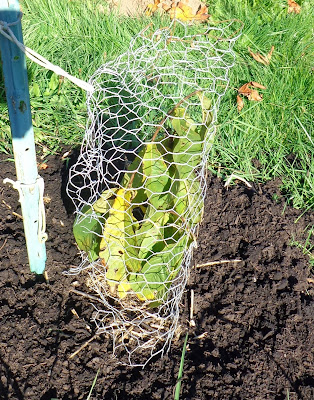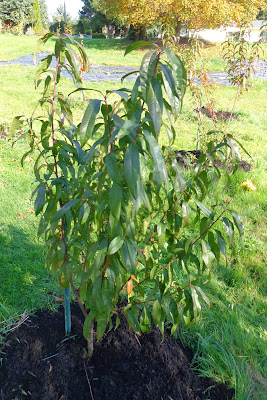 |
| Cherry "Almaden Duke" |
 |
| Jujube "Li" |
Duke Cherry "Almaden Duke". Now 6 ft tall. Growth this year, 6". Transplant from Vancouver yard last fall.
Ginkgo seedling from Illinois. My dad's collected seed, tree is the smallest of the 3 I grew. 6ft tall, growth 0 inches. There were tufts of new growth from each node, but no stem extension. Leaves remain green so far.
Madrone. New planting this fall. 6 ft tall.
Sweet Cherry "Vandelay". New bare root from Raintree, started late this winter, before my surgery. 3'8" of which 2" is new.
Sweet Cherry Sweetheart. As for Vandelay. 3'10" of which 1'2" is new. Bloomed after planting, no fruit.
"Greenspire" Linden, South side of yard near house. 6'6" of which 1'6" is new.
Jujube "Li". Planted as container plant last fall. about 1 ft tall, of which 6" is new.
Pawpaw "NC-1". All pawpaws were planted summer 2012. 2'7" of which 7" is new.
 |
| Pawpaw "NC-1" |
Pie Cherry "North Star". Planted as container tree from Lowes, late Spring. This tree is 5'4". Growth occurred before I planted it, about 1 ft was new. This tree had cherries when I bought it.
Pie Cherry "Montmorency". 6'3". I moved this from Vancouver last summer. 18" of the growth was this year. This tree bore cherries this year.
Wild Plums - grown from seeds summer / fall 2012. Tallest is 4'3", next is 3', and smallest is 2'.
Peach "Indian Blood". Now 4' tall, of which 1ft 4 inches is new.
Persimmon "Seijo". Now 4'10", of which 15" is new. This was bare root planted this year, from Raintree. The growth was nice, but there is a wound on the north side, narrow, extending much of the old stem. The wound is about a mm wide. I don't know what that bodes for next year.
 |
| Pawpaw "Rebecca's Gold" |
 |
| Peach "Charlotte" |
 |
| Peach "Oregon Curl-Free" |
 |
| Peach seedling and Grape "Price" |
Peach "Oregon Curl Free". Total 4'5" of which 3'7" is new. Same issues as for "Charlotte"
 |
| Pawpaw "Sunflower" |
 |
| Pie Cherry "Surefire" |
Apple "Red Sentinel" 2'4" tall and "Golden Sentinel" 2'4" tall. Minimal added height this year. These were planted last summer. The rootstock may be super-dwarfing.
Linden "Greenspire" in front yard. This was the first of the Lindens. 9" tall of which 1" is new.
Peach Seedling 8" - unknown parentage, suspect genetic dwarf. Volunteer in vegetable bed, which was treated with compost. If it develops leaf curl, I don't plan to keep it The "Price" grape 8" was a cutting from my vines at home.
American Linden "Redmond" 5 ft tall, 4" is new. This was container tree planted last winter.
Pear "Rescue" 4 ft tall, 9" is new, and pear "Orca, 4 ft, 9" is new. Both bare root trees from Raintree, planted late winter 2013.
Apple "Spitzenberg" 3" of new growth on 6" of rootstock. This was new graft, grown from new graft early Spring and given TLC with fertigation; Apple "Sutton's Beauty" 1'6" of new growth on 6" rootstock, same situation.
Chinese Haw "Red Sun", 4'8" of which 1" is new. Bare root from "One Green World" nursery planted last fall.
 |
| Plum "Stanley" |
 |
| Sweet Cherry "Sweetheart" |
 |
| Plum "Toka" |
Plum "Stanley" 7'6" of which about 2' is new. Moved from Vancouver last year.
Plum "Toka" 5'10" tall, of which 1'4" is new and plum "Satsuma" 5'6" of which 3" is new, both bought as potted trees last summer on sale at Home Depot.
The Sourwood I planted in Sept, is 7'8" tall.
I've started applying a layer of compost around each tree. Ran out, more expected with another truckload of compost this week.







































